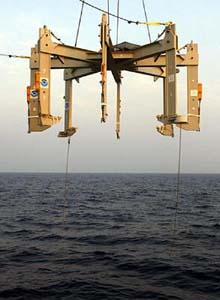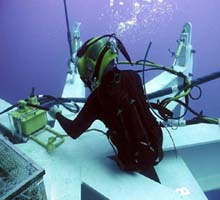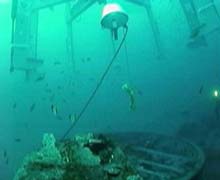
The "Spider," which will lift the Monitor's turret from the ocean floor, is lowered into the water from the derrick barge Wotan. Click image for larger view and detailed explanation.

Navy Diver Petty Officer Steve Grier works to adjust one of the Spider's legs. Click image for larger view and detailed explanation.

The Spider looms over the top of the Monitor's turret after it was deployed on July 17, 2002. Click image for larger view and detailed explanation.
The Spider has Landed
July 17, 2002
Chief Warrant Officer Rick Cavey
Project Diving and Salvage Officer
Monitor Expedition 2002
The day breaks like so many others, light breezes and a slight chop in the seas. The forecaster promises flat, calm conditions as the day progresses. It will have to be today. “Make preps to deploy the Spider,” I tell Master Diver Fred Orns. Commander Bobbie Scholley and NOAA’s John Broadwater agree.
Three weeks of diving to uncover the turret and years of planning behind us, we’re ready to lower the “Spider” over the turret. The Spider is an eight-legged steel “claw” that will securely grip the turret for the final lift. Today, the Spider will be lifted from the deck of the barge, suspended over the side, then slowly lowered 230 feet to the sea bottom. The target—the Monitor’s revolving gun turret.
The 25-ton Spider was designed and engineered by a team of engineers from NAVSEA, Mobile Diving and Salvage Unit TWO, and Phoenix International. Its eight legs are splayed out 15 degrees from vertical for initial placement over the turret. Once in alignment around the turret, the legs will be hydraulically pumped back to vertical, and the feet will slip under the turret and encase the turret in a steel cradle. Synthetic lifting slings then will be shackled to the top of the legs, and Manson Gulf’s 500-ton crane will lift the turret from the ocean floor. It looked great in the drawing room.
At 6:40 am, the crane picks the Spider off the deck and swings it slowly to the water’s edge. “Lower it fifty feet in the water,” I tell Manson’s deck foreman, Gene Wells. Luke Chouest, smoothly lowers the Spider into the water. At this point, Master Diver Jim Mariano deploys his divers to extend the eight legs 15 degrees. Using hand sledges, the divers drive the keeper pins from the legs—not an easy task as the currents and wave surges work against them. They wrap their legs around the Spider’s legs to keep themselves from being sucked away. Mariano chose his divers well. Petty Officers John Coffelt and Steve Grier complete the task and meet their decompression obligations quickly. The crane begins to slowly lower the Spider to the bottom. “Take it to 200 feet, then stop and hold it,” I tell the deck foreman as I make my way to the remotely operated vehicle (ROV) control van. The diver’s time in the water is limited and I want to use the ROV, (a small underwater robot equipped with among many things a video camera) to roughly spot the Spider over the turret. After a few quick commands to the crane, the Spider hovers 20 feet above the turret. The ROV screen displays the scene. “Deploy the saturation diver,” I bark over the radio. Master Diver Brian Van Horn replies with a quick crisp, “Roger.”
Moments later the Saturation (SAT) diving bell comes into view on the communications and video van monitors. The SAT diver, Master Chief Steve Hall, swims from the bell and directs some additional crane movements. Ten minutes later, the Spider hovers six feet directly over the turret. The diver patiently waits for my next move. He can stay on the bottom for up to six hours. Once his dive is finished he returns to a pressurized chamber where he’ll eat, sleep and prepare for another day of diving. He will meet his decompression requirements a week from now when his underwater tasks are completed.
I now have two views of the Spider and turret, one from the ROV, the other from the helmet-mounted camera on the saturation diver. With only 16 inches of tolerance between the Spider’s claws and the 140-year-old turret, I’ll need more eyes on the bottom. Master Diver Scott Heineman prepares another set of surface-supplied divers, Chief Petty Officers Vern Malone and Brad Flemming, to send to the bottom. These divers have an extremely limited time in the water. Decompression requirements limit them to 30 minutes on the bottom. They must get down there quickly and guide the Spider down before their bottom time is up.
The surface-supplied divers have made it to the bottom and I now have four views of the turret. The divers and ROV surround the turret at the 12, 3, 6, and 9 o’clock positions. Slew left, boom down, hook up, come the commands from the lead diver, Master Chief Hall. Slowly the final adjustments to the Spider’s position are made. “Ready to come down?” I ask Mariano, who is in communication with the divers. He nods his head, yes. I watch as the surge from the waves above draw the Spider slowly up and down. I think of Charlotte watching over Wilbur in that classic children’s novel (Charlotte's Web), then a lull in the waves and it becomes still. “Lower down, lower down!” I holler across the deck to the day shift deck foreman Bob “Zag” Lackey. He relays the command to the day shift crane operator Oren “Bub” Haydel. (This delicate operation has now extended into the next shift, so some of the personnel have changed.)
A cloud of bottom silt and excited voices from the divers is all I see and hear. “Are the divers OK?” I ask? My first concern. “Divers OK!” is the report back. “Give me a survey of each quadrant,” Mariano tells the divers. As the silt slowly settles, one diver humorously reports, “The Spider has landed!” And for a brief moment our accomplishment feels no less important than the event he so subtlety reminds us of.
Chief Warrant Officer Cavey is currently stationed at Mobile Diving and Salvage Unit TWO in Little Creek, Virginia.
Sign up for the Ocean Explorer E-mail Update List.

































